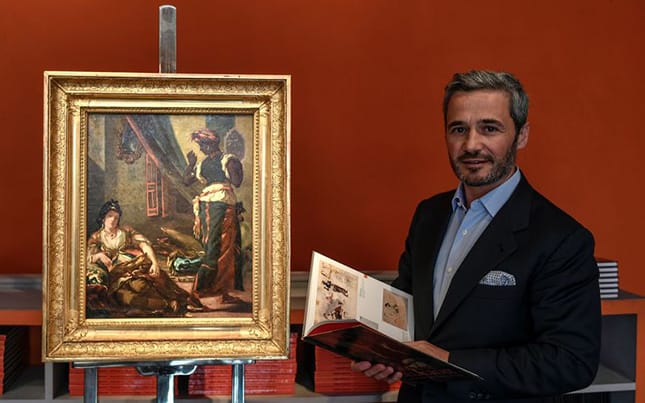French painter Eugène Delacroix did many preparatory works for his 1834 masterpiece, “Women of Algiers in Their Apartment.” One of these preliminary paintings disappeared in 1850 after it was sold to French diplomat Charles-Edgar de Mornay, with whom Delacroix traveled to Algeria with in 1832.
Now, reports Agence-France Presse, art historians have unveiled the lost version, which was discovered in a Paris apartment 18 months ago.
The painting, which depicts a wealthy woman reclining as a black servant looks on, went on display at the Mendes Gallery this week.
The work was found by gallery owner Philippe Mendes in the home of an art collector. It was authenticated by Virginie Cauchi-Fatiga, a leading Delacroix expert, following X-ray and infrared testing. It’s believed the canvas was painted in 1833 or 1834, just before the artist presented the final artwork at the Salon de Paris of the Académie des Beaux-Arts.
The painting will remain on show at the gallery until July 11 before briefly traveling out of Europe.
Delacroix was already a famous painter by the time he made his Algiers painting. In 1832, just a couple years after the French conquest of Algeria, the artist traveled to that country on a six-month journey with Mornay, writes Malika Bouabdellah-Dorbani for the Louvre museum. There, Delacroix soaked in the sights, sounds and culture, heavily romanticizing the experience. “There are Romans and Greeks at my doorstep,” he wrote. “I know now what they were really like. . . . Rome is no longer in Rome.”
While he was often deterred from sketching Muslim women on his travels, during a stop in Algiers, he was able to finagle his way into a harem, the part of a house where women lived that was off limits to men who did not have permission. Inside, he was able to sketch several women, including Mouni and Zohra Bensoltane, who appear in the final painting. It’s not clear what their relationship to the merchant owner of the house was, whether they were wives, daughters or other relatives.
In many ways, the truth did not matter. Delacroix’s image is classic Orientalism, a prevailing colonial attitude toward the Near and Middle East that steeped the land and people in mystery, mysticism and romanticism. The fantasy Orient is the opposite of how Europeans thought of themselves—chaotic, despotic and overtly sexual instead of rational, self-controlled and refined.
Despite post-colonial criticism of the work, “Women of Algiers in Their Apartment” is still very popular with the public. In fact, last fall it was one of the major draws at the Metropolitan Museum of Art’s Delacroix retrospective. The same retrospective, presented at the Louvre earlier last year, set a new attendance record for the museum, with over half a million people peering into the famed Algerian apartment.
